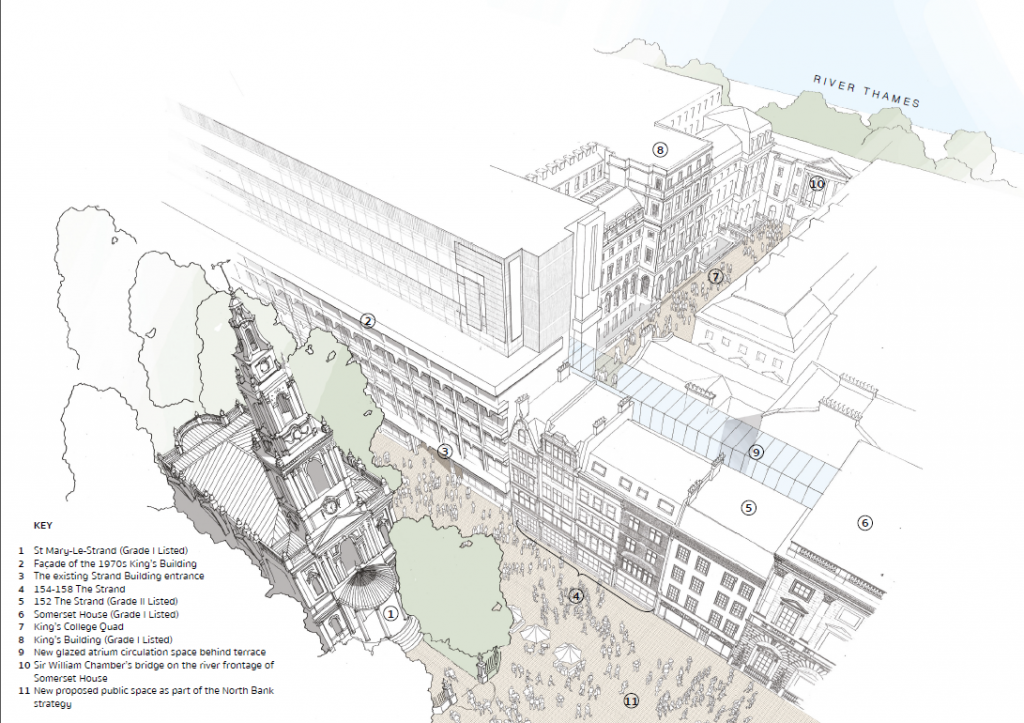Press release: The King's Pavement - A new lease of life for 152-158 Strand
20 November 2015
PRESS RELEASE: THE KING’S PAVEMENT - A NEW LEASE OF LIFE FOR 152-158 STRAND. SAVE’S PROPOSALS FOR A KING’S PAVEMENT IMPROVING THE SETTING OF SOMERSET HOUSE, KING’S COLLEGE AND THE BAROQUE GEM OF ST MARY-LE-STRAND
Following a fast and furious campaign earlier this year to halt the proposed demolition of 154-158 Strand and the façading of 152-153, SAVE began work on an alternative scheme to safeguard their future, with architect John Burrell of Burrell Foley Fischer. The result is a report that proposes a means of saving the buildings in their entirety and places them at the centre of a fantastic new piece of public realm for the capital, half way along the country’s main processional route between Westminster and Buckingham Palace and St Paul's Cathedral and the City.
SAVE’s proposals address King’s College’s chief concerns about the once threatened buildings and proposes a way to bring them back into use and bring St Mary-le-Strand back from its current isolation on a traffic island.
The proposals contain an analysis of the buildings themselves, their immediate context and the wider context of the Strand as a whole. One of the crucial relationships that has been lost is that between the river and the Strand – this could be re-established to the great embellishment of the city.
A cross section of the Strand buildings shows how they can be used and restored for university use, including a new lecture hall at basement level. A glass atrium on the back of the buildings addresses the issue of the varying floor levels of Nos 152-158 and allows them to be interconnected.
SAVE has sent a copy of the plans to the Principal of King’s College Edward Byrne and the Chairman of the Estates Strategy Committee Jamie Ritblat.
The report can be viewed online here. Hard copies are available for a minimum donation of £10. Please donate via JustGiving, and email SAVE with your postal address.
An extract from the proposals:
“SAVE considers that wherever these narrow frontages survive, in the City or streets leading up to it such as the Strand, it is vital that they are preserved. In this case they form an essential part of the townscape of one of London’s best known streets. This is one of the most historic streets in the City of Westminster.
This streetscape has already been damaged by King’s College’s Brutalist building to the east of Somerset House, that was built on the site of at least a dozen similar buildings that were demolished. No further encroachment of this kind should be allowed. The character of central London depends on a balance between large institutional and commercial buildings and smaller scale buildings on narrow plots. These buildings are in an important Conservation Area; they contribute significantly to its specific character and must be retained.
Historic buildings can be upgraded in order to improve their environmental performance, and make them more easily accessible. Research has shown that the demolition of buildings represents a significant loss to the environment - of the embodied energy required to construct the building, and the materials from which it is made.
Retention of entire historic buildings as opposed to just façades is not down to whether internal details survive or not - these can be replaced - it is about layout, interior spaces, and the preservation of a historic building as a whole."
Background
Our intervention secured a Public Inquiry from Secretary of State Greg Clark, and our petition, launched after Westminster Council voted to permit the scheme, gained 10,000 signatures in only two weeks – our most popular petition to date, which reflected the strength of public feeling about these buildings. This was supported by the extensive coverage and letter writing campaign in The Times and the Evening Standard. Historic England changed its stance following this public scrutiny.
SAVE began to assemble a team with Richard Harwood QC of 39 Essex Street, and Susan Ring from Richard Buxton Environmental Law. However, before a Public Inquiry could take place King’s College chose to withdraw their application to demolish the buildings.
SAVE works by proposing workable and sensitive alternatives to demolition, in conjunction with some of the best practitioners in the field. We have previously worked with John Burrell on alternative designs for Smithfield General Market.
SAVE Director Clem Cecil says: “We devised these proposals in response to overwhelming public support to save these buildings. They are good ordinary buildings of the kind that Londoners and visitors to the capital identify with. They are also an important counterpoint to the grander buildings of the Strand. We hope that King’s will take our scheme into consideration as they move forward with their plans to improve their campus, which is also an integral part of the city.”
SAVE President Marcus Binney says: “Creating a new entrance aligned on the portico of St Mary-le-Strand will open up one of the great lost views of London through to one of the colonnade bridges over the Thames designed by Sir William Chambers. The vista will be a delight in both directions and the once threatened buildings will enjoy a new lease of life embellishing the Strand, the nation’s main processional route.”
For more information and images, please contact the SAVE Office on 0207 253 3500 or office@savebritainsheritage.org, or Clem Cecil on 07968 003 595
Burrell Foley Fischer can be contacted on: 0207 620 6114 or through http://www.bff-architects.com/
Notes to Editors
SAVE Britain’s Heritage has been campaigning for historic buildings since its formation in 1975 by a group of architects, journalists and planners. It is a strong, independent voice in conservation, free to respond rapidly to emergencies and to speak out loud for the historic built environment.



